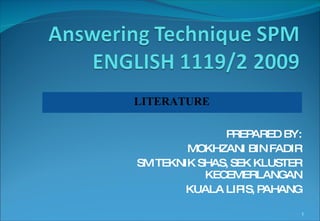Literature
- 1. PREPARED BY: MOKHZANI BIN FADIR SM TEKNIK SHAS, SEK KLUSTER KECEMERLANGAN KUALA LIPIS, PAHANG LITERATURE
- 4. Analysis of Past-Year Question Papers (2001 - 2009) SPM YEAR PAPER Poems Short Stories Novel 2001 Si Tenggang ŌĆśs homecoming The Necklace Favourite Character 2002 If The Sound Machine An Important Moral Lesson 2003 Monsoon History The DroverŌĆÖs Wife A Character you sympathize with 2004 Sonnet 18 The Lotus Eater Most Memorable event and reasons 2005 Si tenggangŌĆÖs Homecoming Looking for A Rain God Theme of Love in a family 2006 The Road Not Taken The DroverŌĆÖs Wife A determined character 2007 Si tenggangŌĆÖs Homecoming The Lotus Eater A Character that you look up to in your life 2008 If The Sound Machine Describe ending and explain why happy or sad 2009 Monsoon History The Necklace. Moral lesson/value?
- 6. Tips and Techniques of Answering Poem and Short Story
- 11. POEM AND SHORT STORIES
- 13. MARKS SCHEME FOR NOVEL MARK CONTENT MARK LANGUAGE 10- 9 An always relevant response to be the task Almost always provides textual evidence Maintains a consistent and convincing point of view 5 Accurate Very well-organised Easily understood 8 - 7 A relevant response to the task Usually provides textual evidence Maintains a consistent point of view 4 Largely accurate Well-organized Easily understood 6 - 5 An intermittently relevant response to the task Provides little textual evidence Point of view consistent in parts 3 Frequent errors but meaning not in doubt Fairly organized Can be understood 4 - 3 A response of very little relevance to the task Hardly any textual evidence Point of view difficult to establish 2 Some blurring in meaning Poorly organized Generally difficult to understand 2 - 1 Shows barely any understanding of the requirement(s) of the task. Point of view not established 1 Makes little/ no sense at all Lacks organization Difficult to understand
Editor's Notes
- #2: Answering Techniques 1119/2_SMT SHAS KUALA LIPIS













